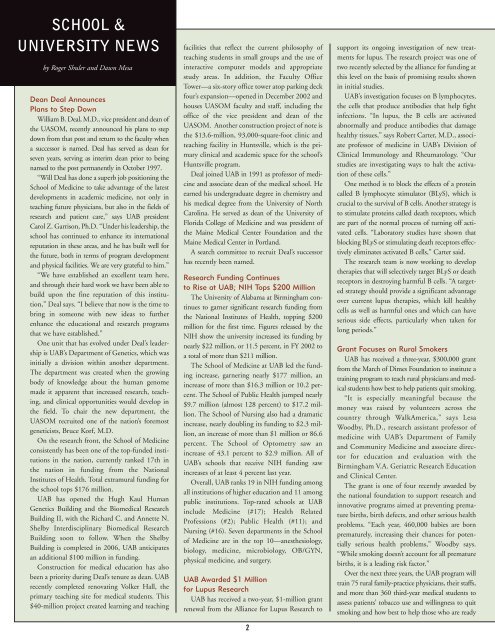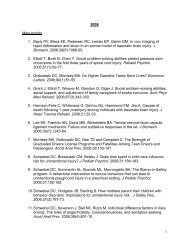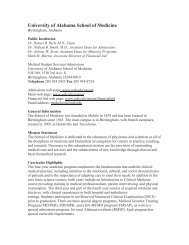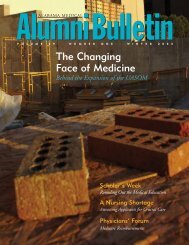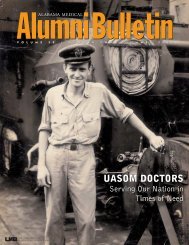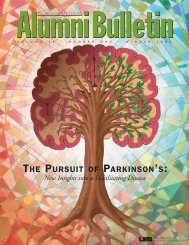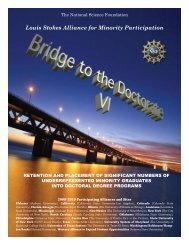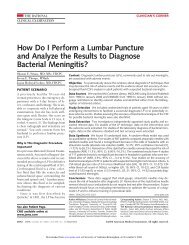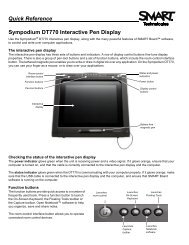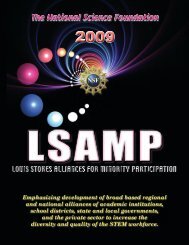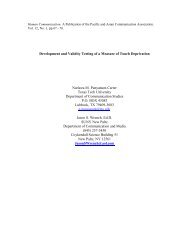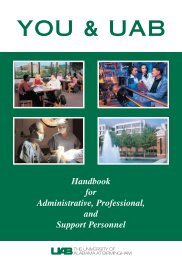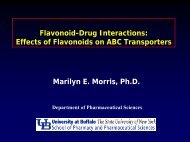AlumniBulletin - The University of Alabama at Birmingham
AlumniBulletin - The University of Alabama at Birmingham
AlumniBulletin - The University of Alabama at Birmingham
Create successful ePaper yourself
Turn your PDF publications into a flip-book with our unique Google optimized e-Paper software.
SCHOOL &<br />
UNIVERSITY NEWS<br />
by Roger Shuler and Dawn Mesa<br />
Dean Deal Announces<br />
Plans to Step Down<br />
William B. Deal, M.D., vice president and dean <strong>of</strong><br />
the UASOM, recently announced his plans to step<br />
down from th<strong>at</strong> post and return to the faculty when<br />
a successor is named. Deal has served as dean for<br />
seven years, serving as interim dean prior to being<br />
named to the post permanently in October 1997.<br />
“Will Deal has done a superb job positioning the<br />
School <strong>of</strong> Medicine to take advantage <strong>of</strong> the l<strong>at</strong>est<br />
developments in academic medicine, not only in<br />
teaching future physicians, but also in the fields <strong>of</strong><br />
research and p<strong>at</strong>ient care,” says UAB president<br />
Carol Z. Garrison, Ph.D. “Under his leadership, the<br />
school has continued to enhance its intern<strong>at</strong>ional<br />
reput<strong>at</strong>ion in these areas, and he has built well for<br />
the future, both in terms <strong>of</strong> program development<br />
and physical facilities. We are very gr<strong>at</strong>eful to him.”<br />
“We have established an excellent team here,<br />
and through their hard work we have been able to<br />
build upon the fine reput<strong>at</strong>ion <strong>of</strong> this institution,”<br />
Deal says. “I believe th<strong>at</strong> now is the time to<br />
bring in someone with new ideas to further<br />
enhance the educ<strong>at</strong>ional and research programs<br />
th<strong>at</strong> we have established.”<br />
One unit th<strong>at</strong> has evolved under Deal’s leadership<br />
is UAB’s Department <strong>of</strong> Genetics, which was<br />
initially a division within another department.<br />
<strong>The</strong> department was cre<strong>at</strong>ed when the growing<br />
body <strong>of</strong> knowledge about the human genome<br />
made it apparent th<strong>at</strong> increased research, teaching,<br />
and clinical opportunities would develop in<br />
the field. To chair the new department, the<br />
UASOM recruited one <strong>of</strong> the n<strong>at</strong>ion’s foremost<br />
geneticists, Bruce Korf, M.D.<br />
On the research front, the School <strong>of</strong> Medicine<br />
consistently has been one <strong>of</strong> the top-funded institutions<br />
in the n<strong>at</strong>ion, currently ranked 17th in<br />
the n<strong>at</strong>ion in funding from the N<strong>at</strong>ional<br />
Institutes <strong>of</strong> Health. Total extramural funding for<br />
the school tops $176 million.<br />
UAB has opened the Hugh Kaul Human<br />
Genetics Building and the Biomedical Research<br />
Building II, with the Richard C. and Annette N.<br />
Shelby Interdisciplinary Biomedical Research<br />
Building soon to follow. When the Shelby<br />
Building is completed in 2006, UAB anticip<strong>at</strong>es<br />
an additional $100 million in funding.<br />
Construction for medical educ<strong>at</strong>ion has also<br />
been a priority during Deal’s tenure as dean. UAB<br />
recently completed renov<strong>at</strong>ing Volker Hall, the<br />
primary teaching site for medical students. This<br />
$40-million project cre<strong>at</strong>ed learning and teaching<br />
facilities th<strong>at</strong> reflect the current philosophy <strong>of</strong><br />
teaching students in small groups and the use <strong>of</strong><br />
interactive computer models and appropri<strong>at</strong>e<br />
study areas. In addition, the Faculty Office<br />
Tower—a six-story <strong>of</strong>fice tower <strong>at</strong>op parking deck<br />
four’s expansion—opened in December 2002 and<br />
houses UASOM faculty and staff, including the<br />
<strong>of</strong>fice <strong>of</strong> the vice president and dean <strong>of</strong> the<br />
UASOM. Another construction project <strong>of</strong> note is<br />
the $13.6-million, 93,000-square-foot clinic and<br />
teaching facility in Huntsville, which is the primary<br />
clinical and academic space for the school’s<br />
Huntsville program.<br />
Deal joined UAB in 1991 as pr<strong>of</strong>essor <strong>of</strong> medicine<br />
and associ<strong>at</strong>e dean <strong>of</strong> the medical school. He<br />
earned his undergradu<strong>at</strong>e degree in chemistry and<br />
his medical degree from the <strong>University</strong> <strong>of</strong> North<br />
Carolina. He served as dean <strong>of</strong> the <strong>University</strong> <strong>of</strong><br />
Florida College <strong>of</strong> Medicine and was president <strong>of</strong><br />
the Maine Medical Center Found<strong>at</strong>ion and the<br />
Maine Medical Center in Portland.<br />
A search committee to recruit Deal’s successor<br />
has recently been named.<br />
Research Funding Continues<br />
to Rise <strong>at</strong> UAB; NIH Tops $200 Million<br />
<strong>The</strong> <strong>University</strong> <strong>of</strong> <strong>Alabama</strong> <strong>at</strong> <strong>Birmingham</strong> continues<br />
to garner significant research funding from<br />
the N<strong>at</strong>ional Institutes <strong>of</strong> Health, topping $200<br />
million for the first time. Figures released by the<br />
NIH show the university increased its funding by<br />
nearly $22 million, or 11.5 percent, in FY 2002 to<br />
a total <strong>of</strong> more than $211 million.<br />
<strong>The</strong> School <strong>of</strong> Medicine <strong>at</strong> UAB led the funding<br />
increase, garnering nearly $177 million, an<br />
increase <strong>of</strong> more than $16.3 million or 10.2 percent.<br />
<strong>The</strong> School <strong>of</strong> Public Health jumped nearly<br />
$9.7 million (almost 128 percent) to $17.2 million.<br />
<strong>The</strong> School <strong>of</strong> Nursing also had a dram<strong>at</strong>ic<br />
increase, nearly doubling its funding to $2.3 million,<br />
an increase <strong>of</strong> more than $1 million or 86.6<br />
percent. <strong>The</strong> School <strong>of</strong> Optometry saw an<br />
increase <strong>of</strong> 43.1 percent to $2.9 million. All <strong>of</strong><br />
UAB’s schools th<strong>at</strong> receive NIH funding saw<br />
increases <strong>of</strong> <strong>at</strong> least 4 percent last year.<br />
Overall, UAB ranks 19 in NIH funding among<br />
all institutions <strong>of</strong> higher educ<strong>at</strong>ion and 11 among<br />
public institutions. Top-r<strong>at</strong>ed schools <strong>at</strong> UAB<br />
include Medicine (#17); Health Rel<strong>at</strong>ed<br />
Pr<strong>of</strong>essions (#2); Public Health (#11); and<br />
Nursing (#16). Seven departments in the School<br />
<strong>of</strong> Medicine are in the top 10—anesthesiology,<br />
biology, medicine, microbiology, OB/GYN,<br />
physical medicine, and surgery.<br />
UAB Awarded $1 Million<br />
for Lupus Research<br />
UAB has received a two-year, $1-million grant<br />
renewal from the Alliance for Lupus Research to<br />
2<br />
support its ongoing investig<strong>at</strong>ion <strong>of</strong> new tre<strong>at</strong>ments<br />
for lupus. <strong>The</strong> research project was one <strong>of</strong><br />
two recently selected by the alliance for funding <strong>at</strong><br />
this level on the basis <strong>of</strong> promising results shown<br />
in initial studies.<br />
UAB’s investig<strong>at</strong>ion focuses on B lymphocytes,<br />
the cells th<strong>at</strong> produce antibodies th<strong>at</strong> help fight<br />
infections. “In lupus, the B cells are activ<strong>at</strong>ed<br />
abnormally and produce antibodies th<strong>at</strong> damage<br />
healthy tissues,” says Robert Carter, M.D., associ<strong>at</strong>e<br />
pr<strong>of</strong>essor <strong>of</strong> medicine in UAB’s Division <strong>of</strong><br />
Clinical Immunology and Rheum<strong>at</strong>ology. “Our<br />
studies are investig<strong>at</strong>ing ways to halt the activ<strong>at</strong>ion<br />
<strong>of</strong> these cells.”<br />
One method is to block the effects <strong>of</strong> a protein<br />
called B lymphocyte stimul<strong>at</strong>or (BLyS), which is<br />
crucial to the survival <strong>of</strong> B cells. Another str<strong>at</strong>egy is<br />
to stimul<strong>at</strong>e proteins called de<strong>at</strong>h receptors, which<br />
are part <strong>of</strong> the normal process <strong>of</strong> turning <strong>of</strong>f activ<strong>at</strong>ed<br />
cells. “Labor<strong>at</strong>ory studies have shown th<strong>at</strong><br />
blocking BLyS or stimul<strong>at</strong>ing de<strong>at</strong>h receptors effectively<br />
elimin<strong>at</strong>es activ<strong>at</strong>ed B cells,” Carter said.<br />
<strong>The</strong> research team is now working to develop<br />
therapies th<strong>at</strong> will selectively target BLyS or de<strong>at</strong>h<br />
receptors in destroying harmful B cells. “A targeted<br />
str<strong>at</strong>egy should provide a significant advantage<br />
over current lupus therapies, which kill healthy<br />
cells as well as harmful ones and which can have<br />
serious side effects, particularly when taken for<br />
long periods.”<br />
Grant Focuses on Rural Smokers<br />
UAB has received a three-year, $300,000 grant<br />
from the March <strong>of</strong> Dimes Found<strong>at</strong>ion to institute a<br />
training program to teach rural physicians and medical<br />
students how best to help p<strong>at</strong>ients quit smoking.<br />
“It is especially meaningful because the<br />
money was raised by volunteers across the<br />
country through WalkAmerica,” says Lesa<br />
Woodby, Ph.D., research assistant pr<strong>of</strong>essor <strong>of</strong><br />
medicine with UAB’s Department <strong>of</strong> Family<br />
and Community Medicine and associ<strong>at</strong>e director<br />
for educ<strong>at</strong>ion and evalu<strong>at</strong>ion with the<br />
<strong>Birmingham</strong> V.A. Geri<strong>at</strong>ric Research Educ<strong>at</strong>ion<br />
and Clinical Center.<br />
<strong>The</strong> grant is one <strong>of</strong> four recently awarded by<br />
the n<strong>at</strong>ional found<strong>at</strong>ion to support research and<br />
innov<strong>at</strong>ive programs aimed <strong>at</strong> preventing prem<strong>at</strong>ure<br />
births, birth defects, and other serious health<br />
problems. “Each year, 460,000 babies are born<br />
prem<strong>at</strong>urely, increasing their chances for potentially<br />
serious health problems,” Woodby says.<br />
“While smoking doesn’t account for all prem<strong>at</strong>ure<br />
births, it is a leading risk factor.”<br />
Over the next three years, the UAB program will<br />
train 75 rural family-practice physicians, their staffs,<br />
and more than 360 third-year medical students to<br />
assess p<strong>at</strong>ients’ tobacco use and willingness to quit<br />
smoking and how best to help those who are ready


